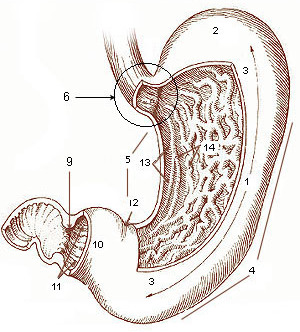Pylorus facts for kids
Quick facts for kids Pylorus |
|
|---|---|
 |
|
| Inside of the stomach (pylorus labeled at center left) | |
| Latin | Pylorus |
The pylorus, or pyloric part, is part of the digestive system that controls the opening between the stomach and the duodenum. The word pylorus comes from Greek πυλωρός, through Latin; it Greek means "gatekeeper."
Contents
Structure

* 2. Fundus
* 3. Anterior wall
* 4. Greater curvature
* 5. Lesser curvature
* 6. Cardia
* 9. Pyloric sphincter
* 10. Pyloric antrum
* 11. Pyloric canal
* 12. Angular incisure
* 13. Gastric canal
* 14. Rugal folds
The pylorus is the furthest part of the stomach that connects to the duodenum. It is divided into two parts, the antrum, which connects to the body of the stomach, and the pyloric canal, which connects to the duodenum.
Antrum
The pyloric antrum is near the bottom of the stomach, and connects to the canal. It usually has a slight curve (see the diagram on the right).
Canal
The canal (Latin: canalis pyloricus) is the opening between the stomach and the duodenum. The pyloric canal wall is up to 1/10 inch (3 millimeters) in infants younger than 30 days, and up to 1/3 inch (8 millimeters) in adults. The pyloric canal ends as the pyloric orifice (another word for hole). The orifice is surrounded by the pyloric sphincter. The pyloric sphincter is a valve that is a strong ring of smooth muscle that opens and closes the canal to control the flow of food from the stomach to the duodenum.
Images for kids
See also
 In Spanish: Píloro para niños
In Spanish: Píloro para niños



